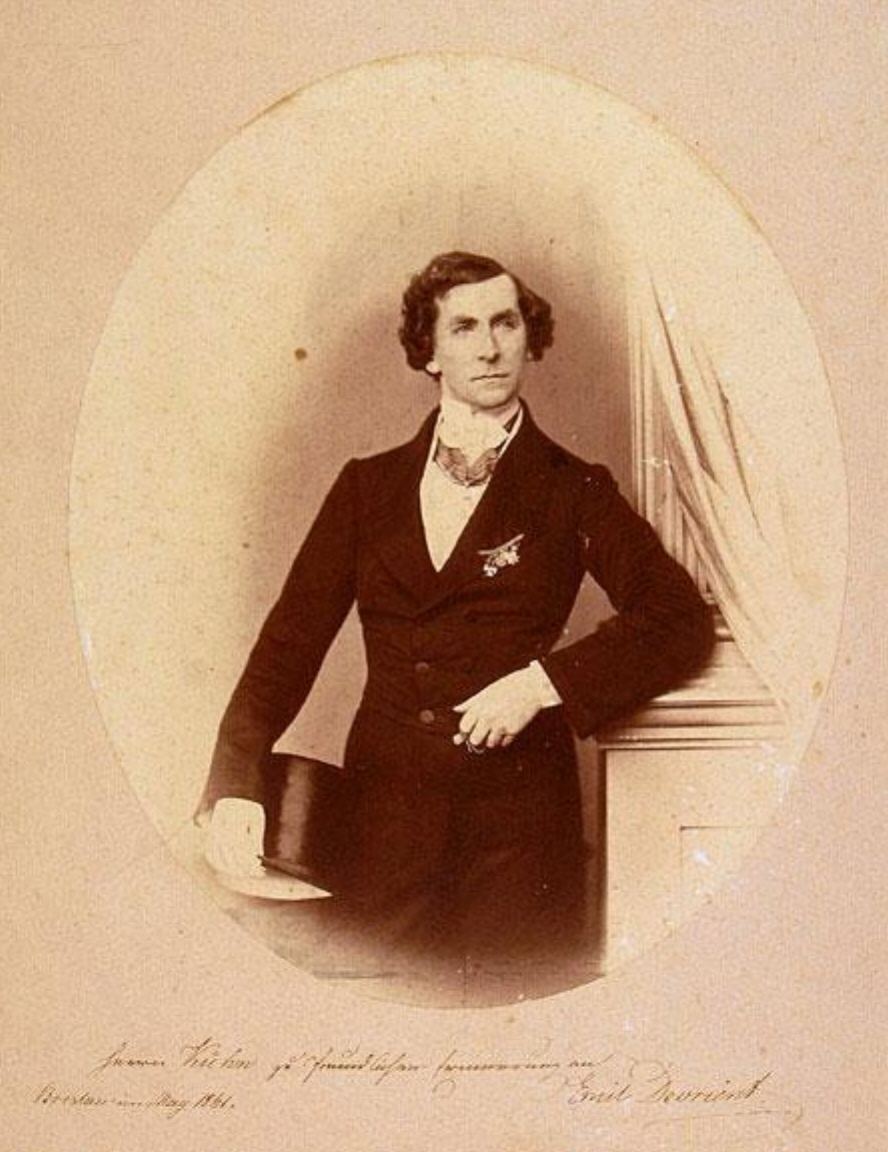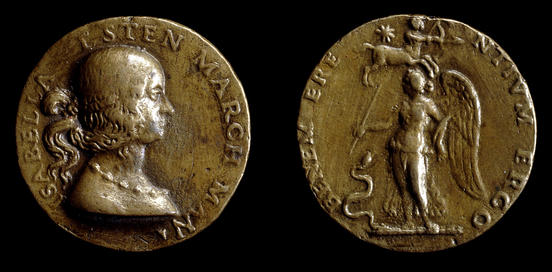|
Emil Devrient
Gustav Emil Devrient (4 September 1803, Berlin – 7 August 1872, Dresden) was a German actor and an occasional operatic bass. Life Gustav Emil Devrient was the youngest son of the six children of the silk merchant Tobias Philipp Devrient and his wife Marie Charlotte. The actors Karl August Devrient (1797–1872) and Eduard Devrient (Philipp) Eduard Devrient (11 August 18014 October 1877) was a German baritone, libretto, librettist, playwright, actor, theatre director, and theatre reformer and historian. Devrient came from a theatrical family. His uncle was Ludwig Devrient a ... (1801–1877) were his brothers, the actor Ludwig Devrient (1784–1832) was his uncle and the actors Max Devrient (1857–1929) and Otto Devrient (1838–1894) were his nephews. The opera singer Wilhelmine Schröder-Devrient was his sister-in-law by her marriage to Karl August. As a youth, Devrient entered an apprenticeship in his uncle's chemical factory in Zwickau, but soon followed his brothers to ... [...More Info...] [...Related Items...] OR: [Wikipedia] [Google] [Baidu] |
Gustav Emil Devrient
Gustav, Gustaf or Gustave may refer to: *Gustav (name), a male given name of Old Swedish origin Art, entertainment, and media * ''Primeval'' (film), a 2007 American horror film * ''Gustav'' (film series), a Hungarian series of animated short cartoons * Gustav (''Zoids''), a transportation mecha in the ''Zoids'' fictional universe *Gustav, a character in ''Sesamstraße'' *Monsieur Gustav H., a leading character in ''The Grand Budapest Hotel'' Weapons *Carl Gustav recoilless rifle, dubbed "the Gustav" by US soldiers *Schwerer Gustav, 800-mm German siege cannon used during World War II Other uses *Gustav (pigeon), a pigeon of the RAF pigeon service in WWII *Gustave (crocodile), a large male Nile crocodile in Burundi *Gustave, South Dakota *Hurricane Gustav (other), a name used for several tropical cyclones and storms *Gustav, a streetwear clothing brand See also *Gustav of Sweden (other) *Gustav Adolf (other) *Gustave Eiffel (other) * * *Gustavo ... [...More Info...] [...Related Items...] OR: [Wikipedia] [Google] [Baidu] |
Hamburg
Hamburg (, ; nds, label=Hamburg German, Low Saxon, Hamborg ), officially the Free and Hanseatic City of Hamburg (german: Freie und Hansestadt Hamburg; nds, label=Low Saxon, Friee un Hansestadt Hamborg),. is the List of cities in Germany by population, second-largest city in Germany after Berlin, as well as the overall List of cities in the European Union by population within city limits, 7th largest city and largest non-capital city in the European Union with a population of over 1.85 million. Hamburg's urban area has a population of around 2.5 million and is part of the Hamburg Metropolitan Region, which has a population of over 5.1 million people in total. The city lies on the River Elbe and two of its tributaries, the River Alster and the Bille (Elbe), River Bille. One of Germany's 16 States of Germany, federated states, Hamburg is surrounded by Schleswig-Holstein to the north and Lower Saxony to the south. The official name reflects History of Hamburg, Hamburg's history ... [...More Info...] [...Related Items...] OR: [Wikipedia] [Google] [Baidu] |
Mitteldeutscher Rundfunk
Mitteldeutscher Rundfunk (MDR; ''Central German Broadcasting'') is the public broadcaster for the federal states of Thuringia, Saxony and Saxony-Anhalt in Germany. Established in January 1991, its headquarters are in Leipzig, with regional studios in Dresden, Erfurt and Magdeburg. MDR is a member of the ARD consortium of public broadcasters in Germany. MDR broadcasts its own television channel to the three states it serves and also contributes programming to the first German TV channel (Das Erste), and broadcasts a number of radio channels. History Origins The Mitteldeutsche Rundfunk AG (MIRAG) was founded on 22 January 1924 in Leipzig. It aired its first program on 1 March 1924 at 14:30 CET. During the ''Gleichschaltung'' in the Nazi era, the MIRAG was transferred to the "Reichssender Leipzig" in 1934. After the end of the Second World War, the Soviet Military Administration in Germany temporarily licensed "Radio Leipzig" in 1945, which only existed for a few months unti ... [...More Info...] [...Related Items...] OR: [Wikipedia] [Google] [Baidu] |
Megabyte
The megabyte is a multiple of the unit byte for digital information. Its recommended unit symbol is MB. The unit prefix ''mega'' is a multiplier of (106) in the International System of Units (SI). Therefore, one megabyte is one million bytes of information. This definition has been incorporated into the International System of Quantities. In the computer and information technology fields, other definitions have been used that arose for historical reasons of convenience. A common usage has been to designate one megabyte as (220 B), a quantity that conveniently expresses the binary architecture of digital computer memory. The standards bodies have deprecated this usage of the megabyte in favor of a new set of binary prefixes, in which this quantity is designated by the unit mebibyte (MiB). Definitions The unit megabyte is commonly used for 10002 (one million) bytes or 10242 bytes. The interpretation of using base 1024 originated as technical jargon for the byte multiples that ... [...More Info...] [...Related Items...] OR: [Wikipedia] [Google] [Baidu] |
DjVu
DjVu ( , like French " déjà vu") is a computer file format designed primarily to store scanned documents, especially those containing a combination of text, line drawings, indexed color images, and photographs. It uses technologies such as image layer separation of text and background/images, progressive loading, arithmetic coding, and lossy compression for bitonal ( monochrome) images. This allows high-quality, readable images to be stored in a minimum of space, so that they can be made available on the web. DjVu has been promoted as providing smaller files than PDF for most scanned documents. The DjVu developers report that color magazine pages compress to 40–70 kB, black-and-white technical papers compress to 15–40 kB, and ancient manuscripts compress to around 100 kB; a satisfactory JPEG image typically requires 500 kB. Like PDF, DjVu can contain an OCR text layer, making it easy to perform copy and paste and text search operations. Free crea ... [...More Info...] [...Related Items...] OR: [Wikipedia] [Google] [Baidu] |
Heinrich Hubert Houben
Heinrich Hubert Houben (30 March 1875 – 27 July 1935) was a German literary historian. From 1907 to 1919 Houben was literary director of the publishing firm Brockhaus. Works * ''Zeitschriften der Romantik'' omantic magazines 1904 * (ed.) ''Gespräche mit Goethe in den letzten Jahren seines Lebens'' onversations with Goethe in the last years of his life 1909 * ''Jungdeutscher Sturm und Drang: Ergebnisse und Studien'', 1911 * ''Verbotene Literatur von der klassischen Zeit bis zur Gegenwart; ein kritisch-historisches Lexikon über verbotene Bücher, Zeitschriften und Theaterstücke, Schriftsteller und Verleger'' anned literature from the classical period to the present 1925 * ''Gespräche mit Heine'' onversations with Heine 1926 * (ed.) ''Zehn Jahre bei Goethe : Erinnerungen an Weimars klassische Zeit 1822-1832'' en years with Goethe: memories of Weimar's classical period, 1822-1832by Frédéric Soret. 1929. * ''Der polizeiwidrige Goethe'' he police against Goethe 1932. * ''Ch ... [...More Info...] [...Related Items...] OR: [Wikipedia] [Google] [Baidu] |
Medaillon
A medal or medallion is a small portable artistic object, a thin disc, normally of metal, carrying a design, usually on both sides. They typically have a commemorative purpose of some kind, and many are presented as awards. They may be intended to be worn, suspended from clothing or jewellery in some way, although this has not always been the case. They may be struck like a coin by dies or die-cast in a mould. A medal may be awarded to a person or organisation as a form of recognition for sporting, military, scientific, cultural, academic, or various other achievements. Military awards and decorations are more precise terms for certain types of state decoration. Medals may also be created for sale to commemorate particular individuals or events, or as works of artistic expression in their own right. In the past, medals commissioned for an individual, typically with their portrait, were often used as a form of diplomatic or personal gift, with no sense of being an award for ... [...More Info...] [...Related Items...] OR: [Wikipedia] [Google] [Baidu] |
Iffland-Ring
The Iffland-Ring is a diamond-studded ring with a picture of August Wilhelm Iffland, a prominent German actor, dramatist and theatre director of the late 18th and early 19th century. The holder, or bearer, of the Iffland-Ring is considered to be the "most significant and most worthy actor of the German-speaking theatre", in the opinion of the previous holder who has passed it to him by will. One exception to this rule came in 1954, when Werner Krauß was not determined by the previous holder Albert Bassermann but by a committee of German-speaking actors. Three times Bassermann had chosen a successor, and on each occasion the actor chosen had died shortly thereafter. Bassermann considered the ring cursed, and declined to choose a fourth successor.''Time'' online published: 26 May ... [...More Info...] [...Related Items...] OR: [Wikipedia] [Google] [Baidu] |
Hofrat
''Geheimrat'' was the title of the highest advising officials at the Imperial, royal or princely courts of the Holy Roman Empire, who jointly formed the ''Geheimer Rat'' reporting to the ruler. The term remained in use during subsequent monarchic reigns in German-speaking areas of Europe until the end of the First World War. At its origin the literal meaning of the word in German was 'trusted advisor' - the word "geheim" (secret) implying that such an advisor could be trusted with the Monarch's secrets (similar to "secretary" in English being linguistically related to "secret"). The English-language equivalent is Privy Councillor. The office contributing to the state's politics and legislation had its roots in the age of absolutism from the 17th century onward, when a governmental administration by a dependent bureaucracy was established similar to the French '' Conseil du Roi''. A precursor was the ''Reichshofrat'', a judicial body established by Emperor Maximilian I of Habsburg ... [...More Info...] [...Related Items...] OR: [Wikipedia] [Google] [Baidu] |
Torquato Tasso (play)
''Torquato Tasso'' is a play in verse by the German dramatist Johann Wolfgang von Goethe about the sixteenth-century Italian poet and courtier Torquato Tasso and his descent into madness. The composition of the play began in Weimar in 1780 but most of it was written between 1786 and 1788, while Goethe was in Italy Italy ( it, Italia ), officially the Italian Republic, ) or the Republic of Italy, is a country in Southern Europe. It is located in the middle of the Mediterranean Sea, and its territory largely coincides with the homonymous geographical .... He completed the play in 1790.Lamport (1990, 90). Notes References * Lamport, Francis John. 1990. ''German Classical Drama: Theatre, Humanity and Nation, 1750–1870''. Cambridge: Cambridge University Press. .Tasso External links English translation of ''Tasso'' Plays by Johann Wolfgang von Goethe 1790 plays Torquato Tasso Plays set in Italy Cultural depictions of poets Cultural depictions of Italian men P ... [...More Info...] [...Related Items...] OR: [Wikipedia] [Google] [Baidu] |
Egmont (play)
''Egmont'' is a play by Johann Wolfgang von Goethe, which he completed in 1788. Its dramaturgical structure, like that of his earlier play '' Götz von Berlichingen'' (1773), is heavily influenced by Shakespearean tragedy. In contrast to the earlier work, the portrait in ''Egmont'' of the downfall of a man who trusts in the goodness of those around him appears to mark a shift away from values. Publication The first edition was published in Leipzig, by Georg Joachim Göschen in 1788. Further editions were published in Leipzig in 1788, 1789, 1790, 1803 and at regular intervals thereafter. The play was translated into French in 1822, and into English by Anna Swanwick in 1850, published in Bohn's Standard Library. Plot In ''Egmont'', Goethe relates the fight of Count Egmont (1522–1568) in the Eighty Years' War against the despotic Duke of Alba. Egmont is a famous Dutch warrior and the Duke of Alba represents the Spanish invader. Though under threat of arrest, Egmont refuse ... [...More Info...] [...Related Items...] OR: [Wikipedia] [Google] [Baidu] |
Hamlet
''The Tragedy of Hamlet, Prince of Denmark'', often shortened to ''Hamlet'' (), is a tragedy written by William Shakespeare sometime between 1599 and 1601. It is Shakespeare's longest play, with 29,551 words. Set in Denmark, the play depicts Prince Hamlet and his attempts to exact revenge against his uncle, Claudius, who has murdered Hamlet's father in order to seize his throne and marry Hamlet's mother. ''Hamlet'' is considered among the "most powerful and influential tragedies in the English language", with a story capable of "seemingly endless retelling and adaptation by others". There are many works that have been pointed to as possible sources for Shakespeare's play—from ancient Greek tragedies to Elizabethan plays. The editors of the Arden Shakespeare question the idea of "source hunting", pointing out that it presupposes that authors always require ideas from other works for their own, and suggests that no author can have an original idea or be an originator. Wh ... [...More Info...] [...Related Items...] OR: [Wikipedia] [Google] [Baidu] |






